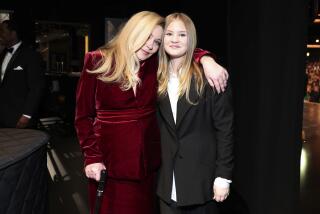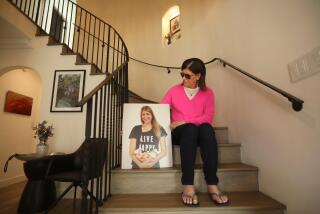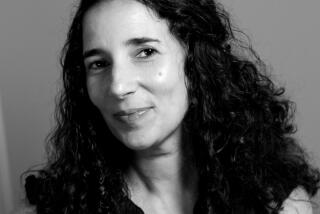A daughter’s cure is priceless
Victoria Jackson doesn’t need this weekend’s retail sales to satisfy her shopping list. She can afford to spend, with her lucrative cosmetics business and a husband with a billion-dollar infomercial marketing firm.
They’ve already put $15 million toward their most important holiday gift, one that can’t be wrapped or put under a Christmas tree, because it’s not something from the mall or a boutique.
It’s the quest for a clean bill of health for their 16-year-old daughter, who suffers from a rare, debilitating disease that has been -- until now -- virtually unknown and ignored by the medical community.
::
It’s easy to begrudge the fortunes of the rich. I admit to a moment of eye-rolling when I first heard of this millionaire mom trying to buy her daughter’s way out of an incurable disease.
Then I thought of all the nights I spent hovering over my ailing kids, worrying about headaches and stomach pains that turned out to be garden-variety illnesses. I imagined listening to a doctor tell me that one of those aches might mean my daughter would lose her ability to walk or see.
That’s what happened to Jackson last year, when a pain in her daughter’s eye landed them in a neurologist’s office. The symptoms -- eye pain, fading colors, loss of vision in one eye -- were diagnosed as neuromyelitis optica, a disorder known as NMO that would have terrified Jackson if she had known then what it is.
“I was in ‘mom denial,’ ” she told me. “I didn’t have any idea of the seriousness of the world I was entering . . . until I heard that in four years, my daughter could be blind or paralyzed. That we could lose her.”
Jackson went from denial into overdrive.
“We spent spring break at the Mayo Clinic,” she said, seeking advice from one of the few physicians who has extensively studied the disorder. She told that doctor, “You’re doing research. I’ve got a checkbook. You and I are going to get to know each other.”
Jackson is blunt and unaccustomed to failure. Sometimes it takes a desperate parent with deep pockets to bypass convention and jump-start medical advances.
Like the mother in Minnesota who sank six years of profits from her successful tech firms into finding new ways to treat autism. She’s convinced that the nonprofit Hyperbaric Treatment Center she funded has improved life for her autistic son and his classmates.
And the Nevada couple whose $5 million launched a research institute that helped document a viral link to chronic fatigue syndrome, a disorder that mystified doctors and afflicted their daughter.
Jackson and her husband, Bill Guthy, founded the Guthy-Jackson Charitable Foundation last year to fund research into NMO, which had been considered a strain of the autoimmune disorder multiple sclerosis, but is now known to require different treatment and have a different prognosis.
The disease tends to strike suddenly, progress quickly, and follow an unpredictable path of remission and relapse. NMO is so rare -- with fewer than 4,000 patients, compared with 400,000 with multiple sclerosis -- that drug companies have no financial incentive to study treatments.
In the past, it often took years to diagnose it, leaving patients with irreversible damage to their spinal cords and optic nerves.
Candace Coffee of Bakersfield woke up one morning six years ago with flu-like symptoms and blurred vision. Within a matter of hours, her vision was gone. “It was like a black curtain going down,” she recalled.
Steroids restored her sight temporarily, but months later, “my right eye started to go . . . and my skin felt like it was being ripped off,” she told me. Before long, the professional dancer “was stumbling around and blind.”
Now, she’s learned to recognize the symptoms and seek immediate treatment. She is blind in one eye, but is dancing again. “But if I’d known what it was, I might have been able to save my sight,” she said. “That’s why getting the word out is so important.”
I met Coffee at a conference Jackson sponsored this month in Beverly Hills. She picked up the tab for scientists flown in from around the world, and dozens of patients from around the country. It was the first time many of them had met anyone else with their disease.
“Can you imagine, in this day when everybody’s got a support group, for these people to feel so alone? I wanted them to be able to sit down together, talk to one another,” Jackson said.
That alone, she said, was worth the money.
::
NMO is just a tiny blip in the medical cosmos. In this world, where medical choices turn on dollars and cents -- from mammograms for 40-year-olds to end-of-life care for octogenarians -- how wise is it, I couldn’t help but wonder, to sink so many millions into something that might help so few?
Then I met Winona Davis, a single mother in Rialto raising two daughters with NMO.
The oldest, now 20, got her first symptoms at 9. She spent her 10th birthday hospitalized; doctors couldn’t figure out why she couldn’t see. Since then, she has battled paralysis and blindness off and on, traumatized not just by the severity of her symptoms, but by their unpredictability.
Until her family attended Jackson’s conference, “we felt like we were aliens,” Davis said.
She’s hoping that the foundation’s work will lead to medical advances to help her daughters. But it’s already been a gift, she said, to other families in their small world.
“The other mothers, now they have a chance to know, to tell someone why their kids can’t ride a bike. So they can have friends. So the other kids aren’t laughing at her when her legs give out, or she wets herself in school.”
“Victoria knows,” Davis said, how frightening it is, how helpless the disease can make a mother feel. “You don’t sleep, you can’t think. . . . You can’t even tell your child what’s wrong. All you can do is try and comfort them.”
Unless you’re a mother with millions to give.
Information about NMO is available at https://www.spectrum . guthyjacksonfoundation.org/ They’ve already put $15 million toward their most important holiday gift . . . It’s the quest for a clean bill of health for their 16-year-old daughter.
More to Read
Inside the business of entertainment
The Wide Shot brings you news, analysis and insights on everything from streaming wars to production — and what it all means for the future.
You may occasionally receive promotional content from the Los Angeles Times.










